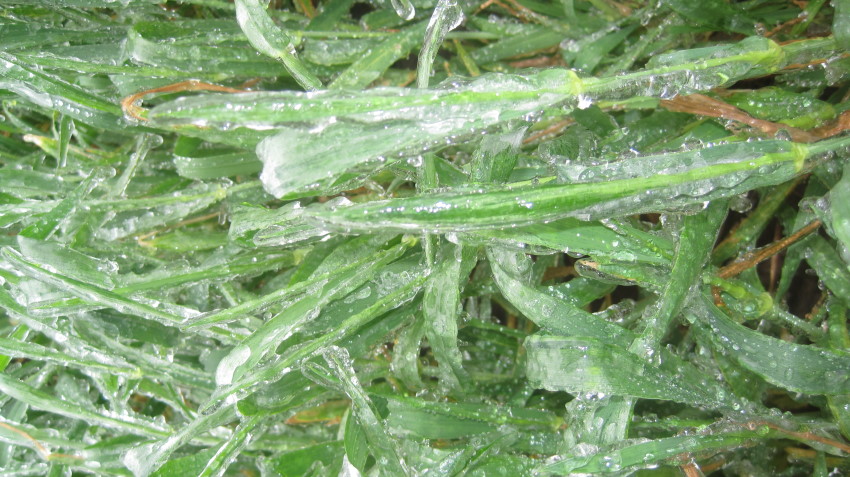
Agricultural News
Oklahoma Wheat Freeze Damage- Waiting to Assess After the Second Shoe Dropped
Thu, 11 Apr 2013 17:42:13 CDT

Two freeze events in wheat country now, mostly in southwest and west-central Oklahoma in March, and now in northwest Oklahoma in early April have wheat producers concerned with lowered if not non-existent yields. Dr. Jeff Edwards, OSU Extension Wheat Specialist, spoke with Radio Oklahoma Network Farm Director Ron Hays about what can be expected from this year's crop. (You can hear their full conversation by clicking on the LISTEN BAR at the bottom of this story.)
"That first freeze event really hit us hard in southwest Oklahoma. It did anywhere from ten to 80 percent damage depending on the field location, how much moisture was there to kind of insulate the crop and create a microclimate. But the damage was fairly widespread and extensive."
North-central and northwest Oklahoma mostly avoided damage from that first freeze, but, Edwards said, area farmers were probably not so lucky with this latest freeze.
"This one, I think there's no question that we're going to have some damage out there. In north-central Oklahoma, I think we had enough moisture there and it didn't get quite as cold as we were expecting. It stayed in the upper twenties and we'll probably lose some primary tillers, but I don't think we're going to have complete losses in north-central Oklahoma.
"The big question for me, right now, is in southwest Oklahoma where the crop was injured. We had some survivors out there. Did we get cold enough to go ahead and take out those surviving tillers? The jury is still out on that."
Edwards said it will take at least a week to learn if the crop has suffered additional damage.
"You can split open stems the day after the freeze and look for ice crystals. That's kind of a telltale sign that things did not go that well, but in terms of accurately assessing the freeze injury you need at least five days and, preferably, about a week to ten days to be able to accurately assess how much injury you have actually sustained."
Writing about the March freeze event in his blog, Edwards said the best-looking wheat suffered the most damage because it was at the most advanced stage and therefore more vulnerable to the freezing temperatures.
"That's hard to deal with because we didn't have that much good-looking wheat to start with in Oklahoma and that's the crop that really got hit the hardest-the more advanced wheat that had really been taken care of."
Edwards said that some of those fields may have had significantly less damage had they been grazed and the wheat not matured as early as it did.
"Our grazed fields are probably the ones that weathered the freeze the best out of anything. Grazing will hold the wheat back and delay development. And, of course, there's a tradeoff there in most years in terms of grain yield. You lose some grain yield because you're removing some of that leaf area, but in a year like this with a freeze, those are generally the fields that make it through the freeze the best."
Edwards said the earliest-maturing varieties are usually the hardest hit due to their advanced development. He said Billings and Jackpot are two varieties that tend to get hit hard by late freezes.
"I think anything that is a Duster maturity or earlier is probably going to be hit harder by the freeze than later-maturing varieties. Things like Endurance, Iba, Winterhawk, some of these that are little later are probably going to come out of the freeze in better shape than something like an Everest or Armour that's on the early side."
Despite recent rains, Edwards said that given the freeze damage, he doesn't believe the state's wheat crop is faring too well at this point.
"I'm still pessimistic on our wheat crop. I still think if we can pull off an average crop we're going to be doing very well in the state of Oklahoma. The freeze has set us back somewhat. Our fields have started to green up. They certainly look a lot better than they did throughout the winter now that we've gotten some moisture, but when you get out there and walk around in those fields, the wheat is not as thick as it should be. And there's really no way to make up for that at this stage of the game. And I think when we roll combines into those fields and harvest, that's going to show up. And I think we're looking for an average to maybe below-average year in terms of total production for the state."
Edwards said producers are also noticing fungus problems this year and he would not be surprised if stripe rust and leaf rust to deal with.
"I know it's tough to talk about right after a freeze event, making those types of decisions in terms of investing in the crop, but in Oklahoma, if we are going to be spraying a foliar fungicide, that decision will need to be made here in the next few weeks."
WebReadyTM Powered by WireReady® NSI
Top Agricultural News
More Headlines...




















